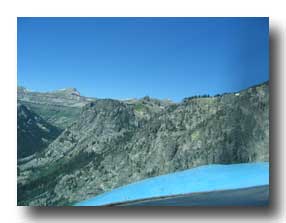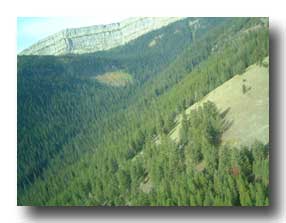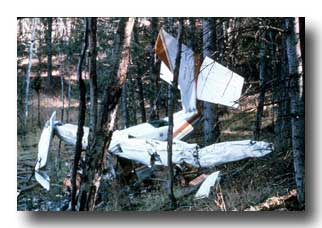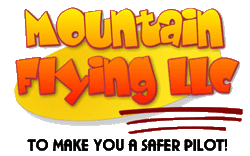The New "Mountology"
The Psychology of Mountain Flying
ACCIDENT REPORTS
Check the National Transportation Safety Board's web site -- http://www.ntsb.gov -- and entering a search for U.S. accidents, single-engine airplanes, western United States, with the word string "rising terrain," produces hundreds of mountain flying accidents.
After perusing the first 90 accidents from 1990 to 2005 on my search, I gave up. The accidents are virtually the same. While the descriptions vary, the cause can be tied to the violation of the two basic premises of mountain flying. It's a shame that the same probable cause for mountain flying accidents occur year after year.
In all these cases the airplane was being operated as visual flight rules (VFR) flight when the accident occurred, visual meteorological conditions prevailed, and no flight plan had been files. Investigation revealed no anomalies with the airplane and the engine operated satisfactorily.
GOBBLEDYGOOK
"I know you believe you understand what you think I said, but I'm not sure you realize that what you heard is not what I meant." This adage, mostly gobbledygook, was adopted by the FAA during the late 1960s for their flight instructor clinics, in an effort to prove the importance of effective communication.
PROPOSAL
My contrived word, "mountology," is used to describe the following proposal. Without careful study this may appear to contain the same type of double talk and confusion as the FAA statement. Because I am going to try to persuade you to train yourself to react in mountain flying situations like Pavlov's dogs (well, at least you don't have to salivate), it is necessary to define some terms. These terms are conditioned, reflex and instinct.
Conditioned in psychology means exhibiting or trained to exhibit a conditioned reflex (response). Reflex in psychology means an unlearned or instinctive response to a stimulus. Instinct means an innate aspect of behavior that is unlearned, complex and normally adaptive.
An instinctive response to a stimulus does not work in an airplane for all situations. For example, when an airplane is in a spin, instinct is to pull back on the control wheel to raise the nose. It has worked before, but now it is not adaptive. In a spin situation you must be trained to move the control wheel/stick forward to break the stall before pulling back on the control wheel. This training is a conditioned response. The basic premises of mountain flying must also be ingrained as a condition reflex.
BASIC PREMISES
Mountain flying known as terrain, contour or drainage flying, as opposed to flying at least 2,000 feet above the mountains, can be done with total safety only when the pilot is conditioned to apply the basic premises during flight.
 |
 |
 |
|
Note the airplane is “hugging” the right side of the canyon to allow for an escape turn back down the canyon. |
Approaching the point of no return. Turn away from the mountain and gain additional altitude prior to going beyond this point. |
Flying beyond the point of no return will result in an accident. |
Basic Premise #1
The first tenant of mountain flying is always remain in a position where you can turn toward lowering terrain.
This saw also encompasses the idea that you will not enter or fly in a canyon where there is insufficient room to turn around. Another way of stating this truth is to have an escape route in mind and be in a position to exercise that option.
Basic Premise #2
The second rule of mountain flying pertains to flight when over or approaching upslope terrain. It states do not fly beyond the point of no return (also called the turn-around point).
This is a place where, if you reduce the throttle to idle and begin a nose-down glide, you will have sufficient altitude to turn around without impacting the terrain. If you are flying with partial flaps extended, such as during a search with half flaps and maybe 80-knots indicated airspeed, you will be surprised at how far down and how fast you will need to lower the nose.
I do not mean to imply that during mountain flying it would be proper technique to reduce the throttle whenever you need to turn around. That's just how you determine the point above the ground where you need to maneuver the airplane away from the rising terrain and gain additional altitude before proceeding along the rising terrain. In most light aircraft you can fly at a safe altitude, maybe 2,000-feet AGL, and configure the aircraft as you would be flying. Note the altitude and reduce the power to idle. Perform a 180-degree turn and note the altitude at the completion of the turn. It's probably going to be around 500 feet.
What you have just determined is the turn-around point. Whenever flying upslope terrain and your altitude approaches 500-feet AGL, turn around and maneuver for additional altitude before proceeding.
You might be thinking, "Now why do I need 500-feet AGL to turn around, that's a power-off altitude?" The answer is that safety dictates that you plan for the unknown and the unexpected, such a downdrafts and turbulence, by giving yourself a buffer.
Another way of stating this is to constantly evaluate where you are and decide if you can lose altitude before having to turn the aircraft. If not, you are narrowing your options substantially and may already be in a position where you are an accident waiting to happen.
BEYOND THE POINT OF NO RETURN
What happens when the pilot flies beyond the "point of no return?"
The first, and usually less serious consequence involves landing the airplane straight ahead into whatever terrain exists. To do this take discipline – discipline that most pilots do not have. It is very difficult to fly the airplane with the nose down enough to maintain airspeed when you have trees and bounders coming at you.
The second outcome involves the stall-spin accident. Because there is insufficient altitude and maneuvering space to complete the turn the pilot tries to hurry the turn with excessive bottom rudder until encountering a stall-spin. This is called a tuck-under spin entry. It doesn't matter at this point about how good you are or even how good you think you are, you just lost a minimum of 400 feet of altitude.
CONDITIONED REFLEX
These aphorisms of mountain flying are not instinctive. They must be conditioned responses. As an example, consider that at some point in your basic flight training your instructor began challenging you to find an emergency landing site. After reducing the power he says something like, "Your engine just failed, proceed as you would during an actual emergency." Soon you become conditioned so that when the instructor pulls the power you already have a suitable landing area picked out in the back of your mind and you head for it. This type training unconsciously caused you to seek an emergency landing area each time you were with the instructor. Eventually the training transfers to encompass the entire time you are flying.
Although you do not need an instructor (Pavlov) to condition you for mountain flying, it certainly helps and it enhances safety. Not all flight instructors providing mountain flight training will expose you to the basic premises. A statement from one of the NTSB accident reports grabbed my attention. "The pilot reported that he had obtained mountain flying training prior to the accident flight and thought he was prepared." It would probably be wise to visit with your chosen instructor before heading out to the hills. Ask the instructor what you will be doing and what techniques you will exposed to during the flight. Find someone who can safely teach you to fly with the mountains rather than making a flight 2,000 feet above the ridges. Once you have learned mountain flying then you can elect to fly 2,000 feet above the highest terrain knowing you are prepared if the weather or a mechanical problem requires a lower altitude.
Safety dictates that you constantly think about the axioms of flight until you become conditioned to remain "unconsciously" in a position where you can turn toward lowering terrain and you are conditioned to never fly beyond the point of no return (turn-around point).
Accident Report Excerpts
|
· The pilot stated that he began a slow full power climb as they approached the terrain and reported that the aircraft’s performance seemed to decline, and “I determined that I would not have sufficient altitude to clear the terrain.” The pilot began a turn to the left to reverse course, however, the engine did not have enough power to complete the 180-degree level turn. · The pilot-in-command made a turn to the west and entered a narrow valley. · The aircraft impacted the side of a mountain while maneuvering. · The witness, who was piloting the number two airplane, stated that the accident aircraft climbed to approximately 8,000 feet (MSL) while flying down the river. He stated that about four miles south of the river, the pilot of the accident airplane turned south up the first drainage and began a descent into the canyon. The witness communicated to the accident pilot that he was in the wrong canyon, stating over the radio “get out of there now.” Shortly after the radio call, the witness observed the accident pilot initiate a turn to the left. Approximately 170 degrees into the turn, the airplane impacted a large tree near the canyon’s edge. After colliding with the tree, the airplane caught fire and subsequently impacted terrain in a nose low attitude. · The pilot’s conclusion of the accident was that he was operating the airplane too low and allowed himself to become trapped in a canyon with rising terrain. · The pilot followed the road through the pass and climbed to 8,200 feet. She followed the road and the terrain continued to climb. The oil temperature began rising as she “traded altitude for airspeed.” Mountains surrounded the airplane, and the pilot was unable to maintain altitude. The airspeed continued to drop below 60 knots, and the pilot extended 10 degrees of flaps. Attempting to avoid a stall, the pilot turned left out of the valley. Shortly thereafter, the left wing clipped a telephone pole and trees came through the windshield. · The airplane collided with terrain while maneuvering. It flew up a canyon, and as it approached a hill, it attempted to increase power. The airplane attempted to climb out, above the canyon, “winged over,” and dived, nose first, into the mountainside. · The aircraft, which was at the very southwest end of a box canyon, impacted the top part of 100-foot tall trees about 500 feet below the pass to the next most westerly canyon at an elevation of approximately 8,040 feet. The surrounding terrain leading up to and along the valley ranged in elevation from about 8,300 to 8,600 feet. · The aircraft impacted rising terrain while maneuvering in the mountains. As they approached the mountain ridgeline in a box-like canyon they attempted to climb to 3,500 feet mean sea level. In order to keep the most altitude between the airplane and the ground, they flew up the center of the canyon valley. Upon observing that they were not going to clear the ridge, the CFI made a left turn and intentionally stalled the airplane in an attempt to make a survivable landing on the mountain slope. · The airplane impacted the terrain while maneuvering. The pilot reported that “after climbing about 10 to 15 minutes heading about 290 degrees up a valley I noticed that the vertical climb rate had decreased to about 100-200 feet per minute, half the climb rate that was expected at full power. The pilot added that the aircraft seemed not to be performing with the power that should be expected at full throttle.” The surviving female passenger, who was seated in the right front seat, reported approximately 5 minutes into the flight, commented to the pilot that “we’re going kinda low.” The pilot responded that the vertical speed indicator was at 1, and should have been at 6.” Approximately 10 minutes later into the flight, the passenger noticed that the airplane was close to the tree tops, and felt like the airplane struck a tree top. The passenger looked at the windscreen, saw a plateau in front of the airplane, and thought “the pilot was trying to land the airplane … we’re going down.” The airplane impacted the terrain, became airborne again and possibly spinning, struck the ground again, and “everything kind of exploded.” · The airplane was substantially damaged during an in flight collision with terrain at the end of a box canyon. The pilot said, “After approximately 30 minutes of flight, I became aware of the narrowing of the valley and the significant rising ground elevation.” When Eisenhower Tunnel (11,000 feet) became visible, he “realized more altitude was required, but full throttle could only produce minimal positive climb.” The pilot said he considered a 180-degree turn, but was concerned about stalling in such a tight turn. He “decided to try climbing through a cleared ski run, just left off I-70,” but subsequently impacted rising terrain at 11,500 feet (14,992-feet density altitude). The POH states that the service ceiling for this airplane was 14,000 feet. · The pilot said he was crossing the Big Horn mountain range approximately 800 feet above each series of ridges. He wrote, “After crossing a set of mountains, we hit a downdraft, causing both loss of altitude and loss of airspeed. We attempted a 180-degree turn to get out of the downdraft, but combined with the rising terrain, we were unable to complete the turn. We hit a tree top at 70 KIAS and then impacted the ground. |
|
|
|

